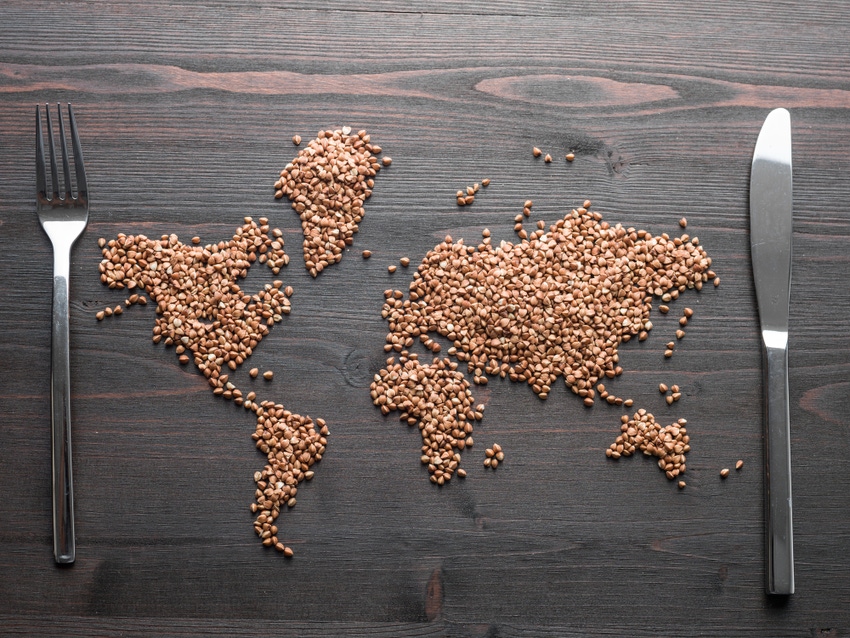FAO trims cereal crop forecasts, notes 45 countries need food assistance.

Global food commodity prices rose sharply in November to their highest level in nearly six years, according to new data from the United Nations’ Food and Agriculture Organization (FAO).
The FAO Food Price Index averaged 105.0 points during the month, up 3.9% from October and 6.5% higher than its value a year earlier. The monthly increase was the sharpest since July 2012, putting the index at its highest level since December 2014, the FAO said.
The FAO Food Price Index tracks changes in the international prices of the most globally traded food commodities. All of its subindices rose in November.
The FAO Cereal Price Index rose 2.5% from October and averaged 19.9% higher than in November 2019. Wheat export prices rose, linked to reduced harvest prospects in Argentina, as did maize prices on account of lower output expectations in the United States of America and Ukraine as well as large purchases by China. International rice prices held steady during the month.
The FAO Dairy Price Index increased 0.9% to near an 18-month high, driven largely by firmer butter and cheese prices and surging retail sales in Europe during a seasonal low period for milk production in the region.
The FAO Meat Price Index rose 0.9% from October, but it is still 13.7% below its value a year ago. Prices of bovine, ovine and pig meats all increased, while those of poultry meat declined.
The FAO Vegetable Oil Price Index gained a stunning 14.5% in the month, led by an ongoing rally in palm oil prices linked to sharp contractions in world inventory levels.
The FAO Sugar Price Index rose 3.3% month-on-month amid growing expectations of a global production shortfall in the upcoming marketing season as unfavorable weather conditions drove weaker crop prospects in the European Union, the Russian Federation and Thailand.
FAO trims world 2020 cereal output forecast
FAO has further lowered its forecast for global cereal production in 2020, which now stands at 2.74 billion metric tons, which is record high and 1.3 % above the previous year's outturn.
The new forecasts released with FAO's “Cereal Supply and Demand Brief” point to world coarse grains production of 1.47 billion metric tons, wheat production of 761.7 million metric tons, and rice output of 508.4 million metric tons.
Looking ahead, FAO said planting of the northern hemisphere's winter wheat crop is underway and remunerative prices are expected to increase sowings in several major producing countries. However, crop conditions in the U.S. are moderately poorer due to dry weather conditions, influenced by the prevailing La Niña weather phenomenon.
World cereal utilization in 2020/21 is now forecast to rise to 2.74 billion metric tons, up 1.9% from 2019/20, led by expectations of increasing feed use of maize and sorghum in China as well as a rise in the production of maize-based ethanol in Brazil and the U.S.
Worldwide cereal stocks by the close of seasons in 2021 are predicted to decline to 866.4 million metric tons, translating into a global stock-to-use ratio of 30.7%, which FAO noted is a five-year low but still a relatively comfortable level.
World trade in cereals in 2020/21 is forecast to rise 3.4% from the previous year to 454.6 million metric tons, driven primarily by a faster than expected pace in maize sales by the U.S. and continued strong purchases from China.
COVID-19, La Niña and food insecurity
The impact of the COVID-19 pandemic, particularly in terms of income losses, is an important driver of the levels of global food insecurity, according to the FAO.
“The pandemic is exacerbating and intensifying already fragile conditions caused by conflicts, pests and weather shocks, including recent hurricanes in Central America and floods in Africa,” the agency noted.
Forty-five countries, 34 of them in Africa, continue to be in need of external assistance for food, according to the quarterly “Crop Prospects and Food Situation” report, which was also recently published by FAO's Markets and Trade division.
According to the report, aggregate cereal production by the 51 low-income food-deficit countries is anticipated to grow this year to 496.3 million metric tons, about 7% higher than the last five-year average, thanks to large outputs in Southern Africa and Far East Asia. However, cereal import requirements in the 2020/21 marketing year are estimated to rise to 73.9 million metric tons, mostly reflecting increased needs among Sub-Saharan African countries.
The report noted that the presence of La Niña heightens the risk of above-average rainfall in Southern Africa and East Asia, while parts of Near East Asia and East Africa are expecting reduced rains, conditions that may result in adverse production shocks.
About the Author(s)
You May Also Like




.png?width=300&auto=webp&quality=80&disable=upscale)
